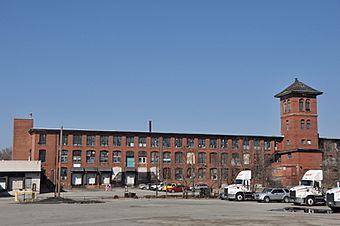Lawton Mills Historic District facts for kids
Quick facts for kids |
|
|
Lawton Mills Historic District
|
|
 |
|
| Location | Roughly bounded by Second St., Railroad Ave., Norwich Rd. and Fifth and Ninth Sts., Plainfield, Connecticut |
|---|---|
| Area | 140 acres (57 ha) |
| Built | 1906 |
| Architect | Lockwood, Green; Carpenter, A.N., et al. |
| Architectural style | Colonial Revival |
| NRHP reference No. | 96000028 |
| Added to NRHP | February 16, 1996 |
The Lawton Mills Historic District in Plainfield, Connecticut is a special area. It shows what a mill village looked like in the early 1900s. A mill village is a town built around a factory, or "mill." This district has many old buildings. Most of them are homes where mill workers lived.
Contents
What is the Lawton Mills Historic District?
This historic district is in Plainfield, Connecticut. It's a well-preserved example of an early 20th-century mill village. The main part of the district is a large brick factory complex. It sits near Railroad Avenue, next to Horse Brook. The mill owners built many homes for their workers. These homes are on both sides of the factory.
The district includes over 100 important old buildings. Most of these are worker houses. They have not changed much over the years. There are also a few shops in the district. These shops provided services for the mill workers. A community hall is also part of the district. Today, this building serves as Plainfield's town hall. The district was added to the National Register of Historic Places in 1996. This means it is a place worth protecting for its history.
A Look at the Mill Village
The historic district has clear boundaries. Norwich Road (Connecticut Route 12) is to the east. Railroad Avenue is to the north. Third Street is to the west. This area was carefully planned around the mill.
Homes for Workers
Between 1906 and 1911, Harold Lawton built 125 duplex homes. Duplexes are houses divided into two separate living spaces. These homes were built in the Colonial Revival style. They provided housing for many of the mill's employees. These houses are still mostly original today.
Community Buildings
Besides homes, the district also had other important buildings. Shops were built to serve the workers. There was also a community hall. This hall was a place for people to gather. Today, it is used as Plainfield's town hall.
The Story of Lawton Mills
The Lawton Mills complex began in 1905. It was started by Harold Lawton. He used to be a manager at another mill in Sprague. The mill doubled in size by 1911.
From Foundry to Textile Giant
Before the mill, this site was a metal foundry in the 1800s. Lawton's mill made fine combed cotton fabrics. It grew very large, with 130,000 spindles. Spindles are parts of machines that spin thread. The mill employed as many as 1,200 people.
The mill's success helped Plainfield grow. The town's shopping area expanded. An opera house, a bank, and several large commercial buildings were built.
Tough Times and Closure
The company faced tough times during the Great Depression. This was a period in the 1930s when many people lost their jobs. The mill closed its doors in 1936. Part of the old mill complex was later torn down. A large modern warehouse now stands in its place.



